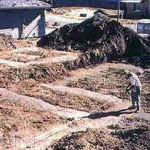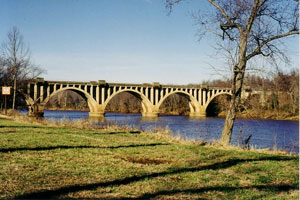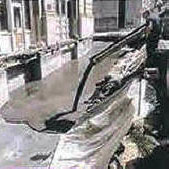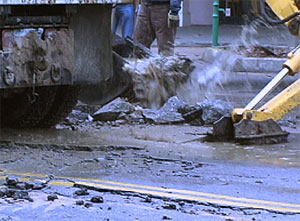Applications
 Unsuitable soil conditions are often thought to be of concern on large commercial projects. However, residential homebuilders are frequently faced with having to excavate several feet before finding adequate soil conditions, and then backfill with suitable material transported to the site, compact the material in 8-12 inch lifts testing each lift for bearing capacity, and finally place their foundation footings. Human error, poor craftsmanship, and material failure have led to numerous complaints from homeowners.
Unsuitable soil conditions are often thought to be of concern on large commercial projects. However, residential homebuilders are frequently faced with having to excavate several feet before finding adequate soil conditions, and then backfill with suitable material transported to the site, compact the material in 8-12 inch lifts testing each lift for bearing capacity, and finally place their foundation footings. Human error, poor craftsmanship, and material failure have led to numerous complaints from homeowners.
Homebuilders in the Northwest have utilized flowable fill for many of their projects simply because it eliminates the need for offsite material, compaction equipment, and extensive labor, while providing superior performance. The flowable fill is delivered to the project site and discharged or pumped immediately into the footings. Oftentimes the foundation footings are placed later the same day.
Backfill
Sewer trenches
Utility trenches
Building Excavations
Bridge Abutments
Conduit Trenches
Structural Fill
Road bases Mud-jacking
Sub-footing
Floor slab base
Pipe bedding
Other Uses
Underground storage tanks
Slope stabilization
Soil erosion control
Mud mats
Abandoned sewers
More and more bridges across the U.S. are beginning to show signs of age, requiring immediate and costly repairs. Many state DOT's have developed different technologies to repair and rehabilitate their bridges without enduring tremendous costs. The use of flowable fill has provided the state DOT's with an effective, economical, timely, and safe means of converting existing bridge structures into a system of culverts passing unseen beneath the roadway.


Soil Erosion Control
Soil erosion is a constant battle along river banks and ocean fronts due to the constant movement of water. Many different types of materials have been used to help alleviate some of the problems resulting from severely eroded areas, but nothing has proven to be a completely acceptable solution. Barriers consisting of rip-rap have been somewhat effective, but oftentimes the soil behind the barrier still erodes away resulting in very costly repairs. Flowable fill has recently been used in conjunction with rip-rap material to minimize problems by preventing the soil from eroding from behind the barrier.
 Several years ago, the Indianapolis Water Company realized that almost 60% of their roadway cuts required repairs only months after completion. By using flowable fill, callbacks were completely eliminated. The Indianapolis Water Company has worked closely with their local ready-mixed supplier to develop a flowable fill mix design that will allow placement of the concrete pavement within an hour of the flowable fill placement while still obtaining the excavatable properties of the mixture.
Several years ago, the Indianapolis Water Company realized that almost 60% of their roadway cuts required repairs only months after completion. By using flowable fill, callbacks were completely eliminated. The Indianapolis Water Company has worked closely with their local ready-mixed supplier to develop a flowable fill mix design that will allow placement of the concrete pavement within an hour of the flowable fill placement while still obtaining the excavatable properties of the mixture.
Water main breaks require immediate attention and often cause traffic congestion as they are repaired. Flowable fill allows the contractor to make minimal lane closures due to its ability to flow several hundred feet while providing 100% compaction.



